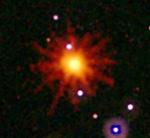
Two studies appearing in the Aug. 25 issue of the journal Nature provide new insights into a cosmic accident that has been streaming X-rays toward Earth since late March. NASA’s Swift satellite first alerted astronomers to intense and unusual high-energy flares from the new source in the constellation Draco.
“Incredibly, this source is still producing X-rays and may remain bright enough for Swift to observe into next year,” said David Burrows, professor of astronomy at Penn State University and lead scientist for the mission’s X-Ray Telescope instrument. “It behaves unlike anything we’ve seen before.”
Astronomers soon realized the source, known as Swift J1644+57, was the result of a truly extraordinary event — the awakening of a distant galaxy’s dormant black hole as it shredded and consumed a star. The galaxy is so far away, it took the light from the event approximately 3.9 billion years to reach earth.
Burrows’ study included NASA scientists. It highlights the X- and gamma-ray observations from Swift and other detectors, including the Japan-led Monitor of All-sky X-ray Image (MAXI) instrument aboard the International Space Station.
The second study was led by Ashley Zauderer, a post-doctoral fellow at the Harvard-Smithsonian Center for Astrophysics in Cambridge, Mass. It examines the unprecedented outburst through observations from numerous ground-based radio observatories, including the National Radio Astronomy Observatory’s Expanded Very Large Array (EVLA) near Socorro, N.M.